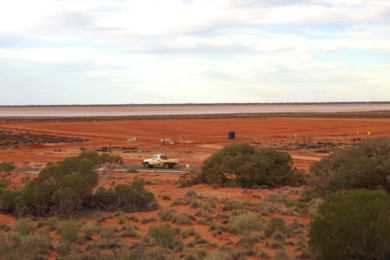Toro Energy announces it will advance to the next stage of the Beneficiation and Process Design studies for the company’s 100% owned Wiluna Uranium Project in Western Australia following the success of the testing so far in confirming opportunities to substantially reduce the capital and operating costs of the processing facility.
The key outcome of the BPD Studies to date has been a re-design of the process flow sheet that has the potential to reduce the capital cost of the proposed hydrometallurgical plant by more than 40% to approximately A$78 million and to reduce the processing operating cost to approximately A$16/t ROM feed. The success of the BPD Studies to date is based on the improved understanding of the different lithologies and uranium associations of the Wiluna deposits, and the novel application of conventional technologies to the processing flow sheet. Beneficiation not only delivered an upgraded uranium concentrate to the leach circuit but also provided the opportunity to investigate filtration and wash cycles prior to the leaching stage. The result is a more efficient hydrometallurgical circuit with potentially significant improvements to capital and operating costs.
Major advances to processing design to date include:
• a beneficiation circuit which has the potential to deliver up to 75% mass reduction whilst maintaining a uranium recovery of as high as 84%;
• a filtration and washing step which removes saline water and produces a drier leach feed thereby reducing reagent consumption;
• unique wash water recirculation to increase reagent utilisation and reduce reagent losses;
• the introduction of ion exchange which removes the need for evaporation ponds; and
• the potential for a gravity separation step to be introduced to further beneficiate ore as well as effectively reject two major reagent consuming gangue minerals
In consultation with the company, Strategic Metallurgy Pty Ltd, which has been engaged for the BPD Studies, has identified four main phases of work required to advance and complete the next stage, focusing on treating Lake Maitland Clay80 ore. These include:
▪ Phase 1: Leaching and Ion Exchange Test work
▪ Phase 2: Metsim® Modeling
▪ Phase 3: Process Package Development
▪ Phase 4: Estimation of the Capital and Operating Costs
The aim of Phase 1 will be to further evaluate and optimise conditions in the leach and ion exchange process operations, part of the hydrometallurgical plant developed in the studies to date. This will entail confirmation of the leaching characteristics and ion exchange efficiency on leach liquors. This may allow for the Sodium Diurinate (SDU) precipitation circuit to be greatly reduced in size or potentially removed altogether. This would enable significant reductions in both capital and operating costs. Focus will also be given to the effect of high chloride levels on the efficiency of ion exchange.
Phase 2 will involve a review and update of the Metsim® model developed in the studies to date. In Phase 2, the model will be updated, where relevant, with data generated in Phase 1 to reflect any changes to the process flowsheet and leaching characteristics of the Lake Maitland Clay80 ore. The model is used to predict process outputs including, but not limited to, process water consumption, reagent consumptions and chloride build up. This provides critical data used to establish design criteria for an updated processing circuit design package for Phase 3. Phase 3 will involve the development of an updated processing circuit design package based on outputs from the Metsim® model and will include equipment sizing and selection. Phase 3 specifically focuses on updates to process flow diagrams, process design criteria and the mechanical equipment list for the processing facility. Phase 4 will involve revising the capital and operating costs based on the output from the processing circuit design package.
It is anticipated that work on Phase 1 of the BPD Studies will be completed during Q3 2018. Toro will determine
whether to progress through the successive phases on a progressive basis which will include being influenced by the results from Phase 1.










